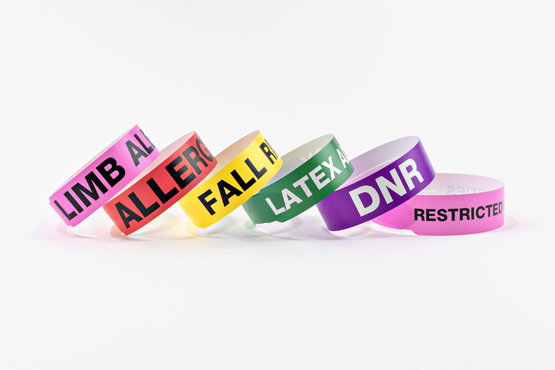How a Patient Identification Band Can Help Prevent Patient Misidentification in Healthcare Settings
How a Patient Identification Band Can Help Prevent Patient Misidentification in Healthcare Settings
Blog Article
Checking Out the Various Types of Patient Identification Band Used in Medical Facilities
In the complex globe of healthcare, the crucial duty of Patient Identification bands typically goes unnoticed. These bands, differing from basic paper wristbands to sophisticated RFID bands, form the backbone of Patient security protocols, making sure precision in Patient Identification.
Understanding the Importance of Patient Identification Bands
While they may appear like simple devices, Patient Identification bands play a vital function in clinical facilities. These bands work as a critical tool for validating Patient identity, stopping clinical errors connected to misidentification. The bands generally present essential info such as the Patient's name, age, blood group, and any type of well-known allergies. They permit health care professionals to rapidly access this essential info, thereby helping with accurate and prompt clinical treatment. Patient Identification bands also help in enhancing administrative tasks, making certain exact record-keeping and billing. In spite of their simpleness, these bands personify the principle of Patient safety and security, a keystone of top quality healthcare. Without them, the risk of medical errors, and consequently, Patient damage, may dramatically enhance.
Standard Paper Wristbands: Their Use and Limitations
Traditional paper wristbands have actually been a staple in Patient Identification across numerous medical facilities. While their use prevails, they harbor certain limitations that might influence their performance in Patient administration. This section will certainly concentrate on the range of their application and the intrinsic disadvantages associated with their usage.
Paper Wristbands: Usage Extent
In the realm of Patient Identification, paper wristbands have long held a crucial function. These bands are commonly utilized in outpatient settings, where the Patient's keep is short-term. Regardless of improvements in technology, the simple paper wristband stays a reliable and cost-effective solution for Patient Identification in various health care scenarios.
Limitations of Paper Wristbands
Regardless of their extensive usage, paper wristbands are not without their downsides. Their physical sturdiness is just one of the significant limitations. Exposure to water, sweat, or harsh handling can make them unreadable and even cause them to break down. On top of that, paper wristbands typically do not have the technological abilities of more modern options, such as barcoding or RFID chips, limiting their performance to just presenting created information. The failure to upgrade or modify the data on the wristband is another imperfection. Furthermore, if the details is transcribed, clarity can be compromised, leading to potential misidentification. Ultimately, paper wristbands can trigger discomfort or skin irritation to some people, specifically when used for prolonged periods.
Barcoded Wristbands: Improvements in Patient Identification
While Patient Identification has long been an important aspect of health care, the advent of barcoded wristbands symbolizes a significant jump forward. These bands take advantage of the simplicity of barcoding innovation, permitting Patient details to be rapidly checked and accessed. They enhance the rate and accuracy of Patient Identification, reducing the danger of clinical errors associated with misidentification. Barcoded wristbands are cost-effective, simple to produce, and get rid of handwriting mistakes typical with hand-operated systems. Nevertheless, they are not without constraints. While they use improvements over standard bands, the barcode can become smudged or worn, making it unreadable. Regardless of this, barcoded wristbands remain a necessary device in contemporary medical care setups, representing the intersection of technology and Patient treatment.
Radio Frequency Identification (RFID) Bands: an Action In The Direction Of Futuristic Medical Care
The advancement of Patient Identification bands has actually brought regarding the appearance of Radio Regularity Identification (RFID) Bands (patient identification band). These ingenious gadgets present essential advantages for healthcare centers, supplying an extra reliable and technically advanced means of Patient Identification. The implementation of RFID in healthcare is a considerable step towards a more futuristic technique to Patient monitoring and safety
Understanding RFID Bands

RFID Bands: Trick Benefits
Mainly, these bands boost Patient safety by supplying exact, instant Identification, consequently reducing medical errors. RFID bands can keep a large quantity of Patient information, including medical history and allergic reactions, allowing customized treatment. Overall, RFID bands represent a considerable innovation in Patient Identification modern technology, benefiting both patients and health care suppliers.
Applying RFID in Healthcare
These bands give a seamless way to track and recognize individuals, guaranteeing their safety and boosting efficiency in therapy procedures. RFID bands minimize medical mistakes by supplying accurate Patient Identification, which is crucial in preventing misdiagnosis or incorrect medication administration. Therefore, the application of RFID bands is a significant action in the direction of improving Patient security and healthcare delivery.

Color-Coded Wristbands: Aiding in Quick and Accurate Diagnosis
In the dynamic setting of a medical center, color-coded wristbands have actually arised as essential devices for swift and precise Identification of a client's medical condition. These wristbands, worn by clients, bring details colors that correspond to different medical conditions or statuses. This system is designed to use instant aesthetic signs to medical care providers, improving Patient security and care top quality.
Techniques for Efficient Execution and Monitoring of Patient ID Bands
Accomplishing ideal usage of Patient Identification bands requires a well-structured method for their application and monitoring. Patient education is additionally crucial; patients must recognize the function of the bands and the requirement for their continuous wear. It's vital to have a backup plan in place, such as barcode scanning or biometrics, to make certain that Patient Identification is never ever endangered.
Verdict
Patient Identification bands are crucial in medical centers to make sure safety and security and precision. Traditional paper, barcoded, RFID, and color-coded wristbands each hold distinct advantages, ranging from cost-effectiveness to sophisticated data storage and instantaneous clinical informs. Reliable execution and monitoring of these bands can considerably reduce clinical errors, increase effectiveness, and enhance general Patient treatment. Hence, understanding and using these Identification devices is extremely important for maintaining high criteria in Recommended Reading health care.
These bands, differing from basic paper wristbands to sophisticated RFID bands, create the backbone of Patient safety procedures, making certain accuracy in Patient Identification.The development of Patient Identification bands has brought about the development of Radio Regularity Identification (RFID) Bands. In general, check out here RFID bands represent a significant improvement in Patient Identification innovation, profiting both clients and health care suppliers.
RFID bands minimize medical mistakes by offering accurate Patient Identification, which is critical in stopping misdiagnosis or incorrect medication management. Patient education and learning is additionally crucial; individuals should recognize the objective of the bands and the need for their consistent wear.
Report this page